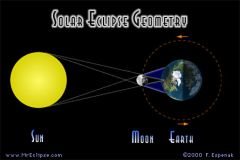![]()
![]()
![]()
Use LEFT and RIGHT arrow keys to navigate between flashcards;
Use UP and DOWN arrow keys to flip the card;
H to show hint;
A reads text to speech;
26 Cards in this Set
- Front
- Back
|
What is the difference between rotation and revolution? |
Rotation is when the axis is in the object, and the object is moving around it Revolution is when the axis is not in the object, and the object orbits around it. |
|
|
The Earth rotates on it's axis at... |
23.5 degrees |
|
|
Perihelion |
The closest approach to a of planet or commit to the sun in orbit. |
|
|
Aphelion |
The most distant point from the sun for object in its orbit. |
|
|
Zenith |
The point directly overhead, at an altitude of 90 degrees |
|
|
Nadir |
The point directly below |
|
|
Elevation |
The angle of an object above the horizon. |
|
|
Equinox |
Two days of the year where when there are 12 hours of daylight (equal lengths of day and night); in the southern hemisphere these are 21 March (Autumn equinox) and 23 of september (Spring equinox) |
|
|
Solstice |
The longest or shortest day of the year, the sun reaches its highest or lowest local solar zenith for the year, these are 22 december (summer solstice) and 21 of June (Winter solstice) |
|
|
Describe the path of the Earth around the sun |
Earth rotates West to East, whilst it revolves East to West |
|
|
Name the tropics and equator in order (top to bottom) |

|
|
|
Name the three methods to find the South Celestial pole? |
Method 1: Start at the two middle stars of the southern cross, then extend a line 4.5 times its own length. Method 2: Extend the the long axis across the southern cross and the pointers, and as soon as these two lines touch, draw a line down, and that the South Celestial pole Method 3: Draw a straight line through the top pointer till the end of the page, and draw a line down from where it is halfway. |
|
|
What direction does the stars, moon and sun move around us? |
They seem to move East to West |
|
|
What is a Sidereal month and a lunar month, and how long are they |
A Sidereal month is the time it takes the moon to complete one full revolution around the Earth with respect to the background stars. (27.3 days) A lunar months the time taken for the moon to go through all of its phases, from new moon to new moon. (29.5 days) |
|
|
What is the Astronomical definition for a day. |
One full rotation on the Earth's axis |
|
|
What is the Astronomical definition for a year. |
One full revolution around the sun |
|
|
What is the Astronomical definition for a month |
When the moon does a full revolution around the Earth. |
|
|
What causes night and day? |
Day is caused when the sun's rays hits one half of the Earth's surface, leaving the other in darkness. |
|
|
Why are there different seasons? |
Because the Earth is on a tilt, the sun hits different parts of the Earth, causing seasons. |
|
|
What is sunrise and sunset? |
When the sun is just seen through the East, and lightness replaces darkness is when sunrise occurs, and as the day passes, the sun leaves our horizon on the west side. This is sunset |
|
|
What is a solar eclipse? |

A solar eclipse is when the moon is close enough to the Earth, to completely cover the sun, and turn it into darkness |
|
|
What is a lunar eclipse? |

A lunar eclipse is when the moon passes through the Earth's shadow. |
|
|
What are the phases of the moon (in order)? |
New moon: All Black Waxing Crescent: Less than 1/4 of the moon is lit 1st quarter: Half, more than half is lit Waxing Gibbous: 3/4 or more is lit Full moon: The whole moon is lit Waning Gibbous: Dark side of the moon is 1/4 lit Last quarter: Half the moon is in darkness Waning Crescent: 3/4 or more of the moon is in darkness New Moon: All Black |
|
|
What would change with the phases of the moon depending on whether you are on the Southern or Northern Hemisphere? |
The way it grows, or shrinks NH: Grows East to West SH: Grows West to East |
|
|
Why does the Moon rise later each day? |
The moon rises later each day, because as the moon is rotating and revolving around the Earth, the time it takes to go through the whole Earth takes longer. |
|
|
What is the Moon's influence on tides? |
The moon's influence on tides is big, because it causes gravitational pull on the water closets to it, while the water on the other sides has even less gravitational pull, so it forms its own little bump, due to gravity. |

